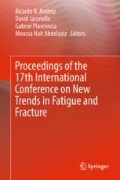Abstract
Fatigue curves (S–N curves) are presented for high density polyethylene pipes (HDPE, PPI 4710 resin) and for PVC pipes, obtained experimentally in a 100 mm diameter and 300 m long water pipeline with pipe samples of different thicknesses subject to repeated cycles of extreme hydraulic transient pressures, which are continued until the failure of the pipe samples. The pipe samples were used either (1) without alterations, or (2) altered with triangular grooves of different depths machined in its external surface, in order to favor the formation of cracks in those grooved sections. From the experiments, it is confirmed that failures have their origin in the cracks developed in weakened regions of the pipes. It is also confirmed that high density polyethylene pipes have high resistance to fatigue or to the cyclic application of high internal pressures, given the fact that for this material the pipe failures: (1) are localized and limited in length, (2) they occur under pressures much higher than its nominal design resistance for normal operating conditions and (3) they occur under pressures which are also much higher than those allowed by the design standards for the case of maximum hydraulic transient events. On the other hand, the experiments confirmed that: (1) PVC pipes do not have the high resistance to fatigue shown by the polyethylene pipes, and (2) PVC pipe failures are brittle and catastrophic, as they propagate very rapidly until the destruction of the pipe. The two polymers tested, which exhibit such different behavior, have very different glass transition temperatures, 90 °C for PVC and −90 °C for HDPE. When compared with the normal range of ambient temperatures, PVC is always used well below the glass transition temperature, behaving therefore as a glass, and HDPE is always used well above the glass transition temperature, behaving as a rubber.
Access this chapter
Tax calculation will be finalised at checkout
Purchases are for personal use only
References
Autrique R., Rodal E. (2012). “Fatiga en tuberías de polietileno sometidas a presiones extremas producidas por golpe de ariete” Memorias, XXV Congreso Latinoamericano de Hidráulica, San José, Costa Rica (in Spanish).
Autrique R., Rodal E. (2014). “Estudio en laboratorio de fatiga en tuberías de polietileno sometidas a presiones transitorias extremas” Memorias, XXVI Congreso Latinoamericano de Hidráulica, Santiago, Chile (in Spanish).
Suresh, S. (1998). Fatigue of materials. Cambridge University Press, 2nd Ed, Cambridge, U.K.
Findley W, Lai J, Onaran K. (1976). Creep and relaxation of nonlinear viscoelastic materials (with an introduction to linear viscoelasticity). Dover, New York, U.S.A.
Ashby, M., Jones, D. (1986). Engineering Materials 2. An introduction to microstructures, processing and design. ISMST, Vol 39, Pergamon, U.K.
Plastic Pipe Institute (2009). Handbook of polyethylene pipe. PPI, 2nd Ed, Irving, Texas, U.S.A.
Joseph, S.H. (1984). “Fatigue failure and service lifetimes in uPVC pressure pipes”, Plastic and rubber processing and applications, Vol 4, No 4, pp 325–330, Plastics and Rubber Institute, England.
American Water Works Association (2010). PVC Pipe Design and Installation. Manual of Water Supply Practices, M 23, 2nd Ed, AWWA, Denver, Colorado, U.S.A.
Author information
Authors and Affiliations
Corresponding author
Editor information
Editors and Affiliations
Rights and permissions
Copyright information
© 2018 Springer International Publishing AG
About this paper
Cite this paper
Ruiz, R.A., Canales, E.A.R. (2018). Laboratory Study of Fatigue in Water Conveying HDPE and PVC Pipes Subject to Extreme Hydraulic Transient Pressures. In: Ambriz, R., Jaramillo, D., Plascencia, G., Nait Abdelaziz, M. (eds) Proceedings of the 17th International Conference on New Trends in Fatigue and Fracture. NT2F 2017. Springer, Cham. https://doi.org/10.1007/978-3-319-70365-7_15
Download citation
DOI: https://doi.org/10.1007/978-3-319-70365-7_15
Published:
Publisher Name: Springer, Cham
Print ISBN: 978-3-319-70364-0
Online ISBN: 978-3-319-70365-7
eBook Packages: Chemistry and Materials ScienceChemistry and Material Science (R0)

